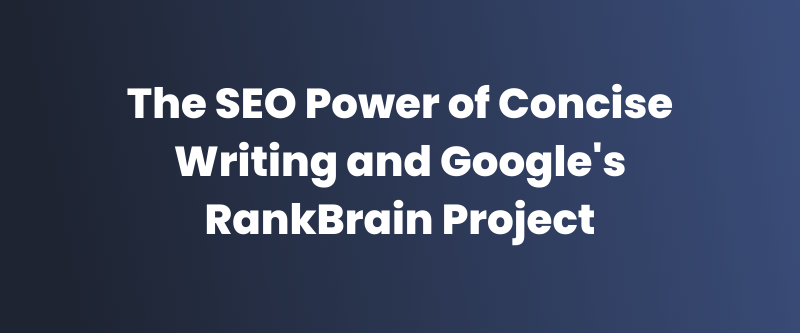We’re in a new year, and from what we’re seeing so far, 2017 is most certainly going to be the year of machine learning thanks to advances in artificial intelligence algorithms and a commitment to push the technology forward.
Helping lead the pack is Google and its innovative platform known as RankBrain. The company’s technology is already regarded by some industry experts as Google’s third-most important ranking factor, and for good reason.
As RankBrain continues to burst onto the scene, it will continue to employ machine learning to teach itself and improve how content is ranked without human input.
Why is Concise Writing So Important With RankBrain?
One of the main issues that Google, Yahoo, and other search engines are still trying to overcome is building enough context around the content being written to offer relevant search results.
RankBrain’s primary focus is to quickly examine content on a page and offer results accurately, even when a user enters a never-before-seen or otherwise unusual query. Through machine learning, users’ unique search requests are continually used to better understand future search strings.
So why concise writing?
Machine learning is making great advances, but it’s not perfect — as its name suggests, it’s always learning. The algorithm will likely learn to parse large amounts of data in the future, but it has to start with a simple foundation.
Take for example a typical article on many websites. In the past, SEO dictated that long-form content with a lot of keyword stuffing would perform at a higher level. Why? Because a search bot would crawl the content, recognize the constant use of a certain keyword or keyword string, and then index that content based on that term. That’s an oversimplification of the practice, but it serves us well in explaining at least part of the RankBrain process.
It’s all about semantics
Semantics is essentially the practice of understanding. For example, if I was to type in the keyword “laptop” in an article, Google may question if I am writing an article about the best prices for a laptop, about how to repair a laptop or thousands of other possibilities.
When RankBrain examines a website, it attempts to find the context of the article so it can parse the semantics needed to rank that content more accurately or higher in its results pages.
Writing in a concise manner cuts out all of the padding, AKA garbage, that is often placed inside of long-form content and therefore provides only the context.
As a general rule of thumb at Zenpost, we find it helpful to give the readers a compelling story that directly speaks to what they have searched for.
Beyond semantics
Google’s engineers have taught RankBrain to use word stemming throughout the crawling process. Word stemming is the ability to focus on a word’s root and ignore its suffix. For example, if you search for “optimize,” the company’s search engine also finds results for “optimizing,” “optimization,” and “optimized.”
Google is also now delivering synonym and concept matching. Type in a search for “incredible stories” and you’ll also find “unbelievable stories” and other matches. Type in “where can I get the best cup of coffee,” and Google now understands that you don’t mean the programming language because of the CONTEXT you placed inside your search.
On top of that information, RankBrain can spatially determine the context of words based on their distance and placement against other words and sentences. Padding an article for the sake of increase the number of words on the page can distance the meaning of the article from this principle.
Be Natural In Your Delivery
This all brings us back to simple and concise writing. When we pad stories for the sake of keyword stuffing, there is almost certainly a point in which the context of the original story becomes convoluted.
How often have you visited a news aggregation or digital media website only to find a story with a bunch of filler? Typically it goes something like this: A celebrity is arrested for a DUI and very little facts are known, the author writes about the DUI and then begins to fill the page with other exploits the celebrity has faced in the past. All of a sudden, the article is less about news of the now and more about trying to throw in the word “DUI” as much as possible.
Natural language processing, context-based semantics, word stemming, and synonym parsing, along with spatial analysis of words and their meanings, allows Google to pick up on the context of a story without the filler. Write about another Lindsay Lohan DUI and Google understands the context. Write about her DUI then her guest spots on various TV shows, and the context may become convoluted.
So what should digital publications be doing right now?
Keep your language natural and avoid too much jargon. Keep in mind that machine learning is always educating itself. In the early days of RankBrain, using too many keywords or non-associative terms could lead to confusion on the part of Google’s newest ranking algorithm addition.
Think about context. Yes, it’s true that Google is working to more easily understand context, but too much jargon and industry type words are still likely to confuse the company’s search bots as they seek out the meaning of your content.
Think about Mobile! The TL;DR culture is more recognizable on mobile than ever before. I personally don’t want to scroll through a 3,000-word article that could have gotten its point across in 300 words. With Google quickly learning to understand context, the more focused you can be with your careful choice of words, the more likely you’ll be to see higher SERPs during mobile searches.
Context. Counterarguments. Concise Writing. I know I keep driving this concept home, but it’s becoming more important on a day-to-day basis. Make sure you develop your explanations, provide examples of what you are writing about, and make sure to address counterarguments that still fall within the purvey of your work.
Final Thoughts
Google is going to continue its assault on traditional SEO practices. I’ve personally been saying for years that traditional SEO is dead — what has been left behind is a bunch of “SEO experts” who are selling the same backlink packages and keyword stuffed content they have been shilling out for years.
Thankfully, Google, Yahoo, and other search engines are finally diving deeper than ever before into context based analysis and natural language processing, which means content can finally live in a realm where keyword stuffing and long content for the sake of long content can finally fall by the wayside.
At Zenpost, we are dedicated to delivering concise but highly-engaging content to all of our clients and their audiences. RankBrain, Panda, and all other aspects of the Google algorithm machine are examined by our team on a daily basis to determine how our content can be improved.
We keep coming to the conclusion that lean, informative, quality content, written for a growing mobile user population is the solution for better engagement both on and off the page.
By following the right formula, we’ve discovered higher conversion rates, more sales, and ultimately a lot of success for our brand partners, and we’ve done it by trimming the fat from articles and focusing on what matters — the reader and the exact context of what they are absorbing.





